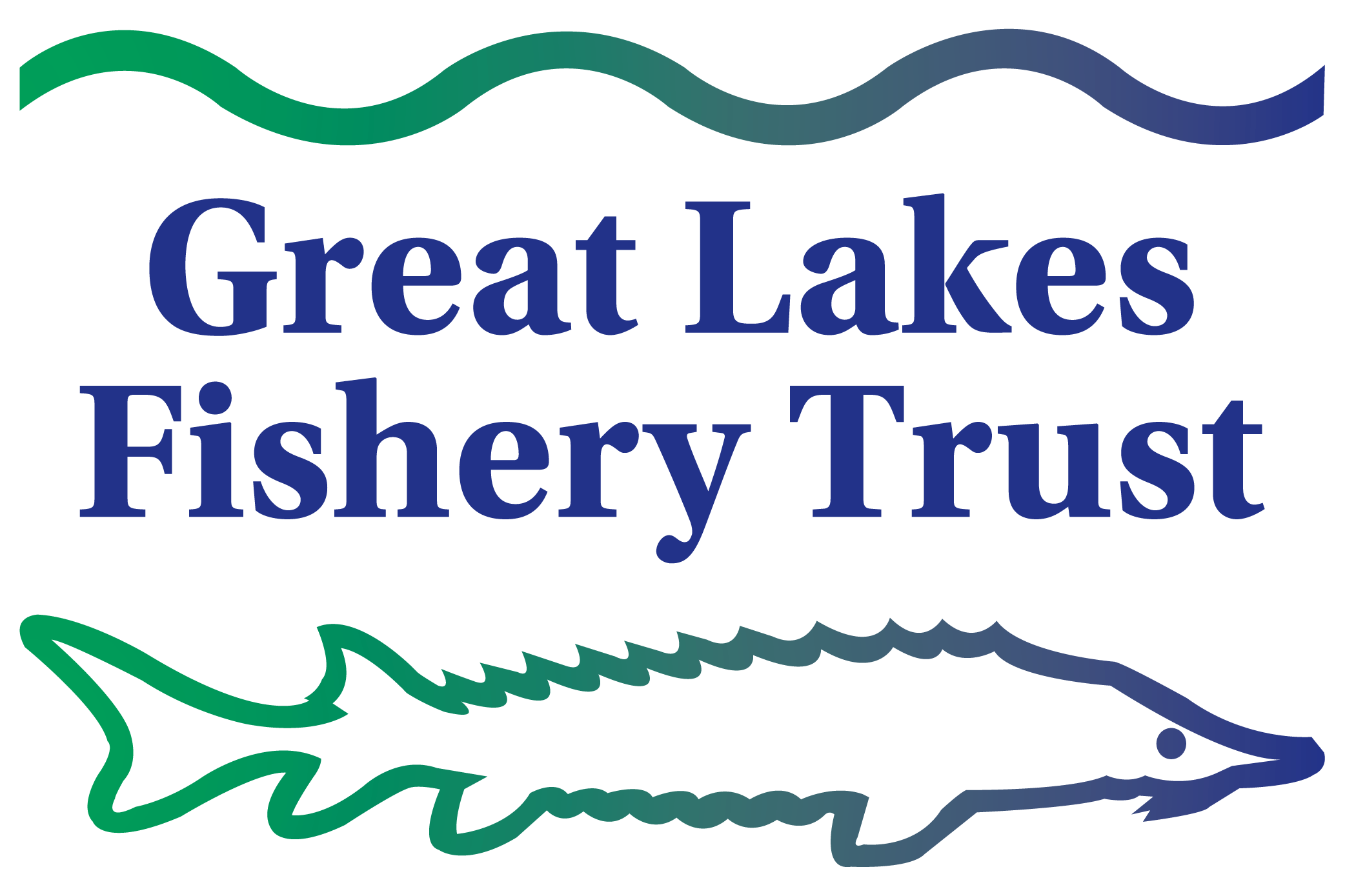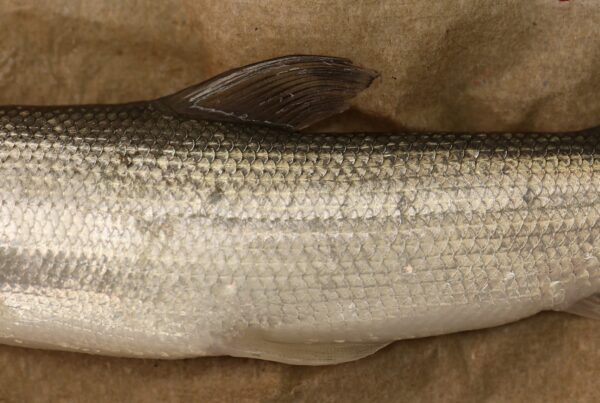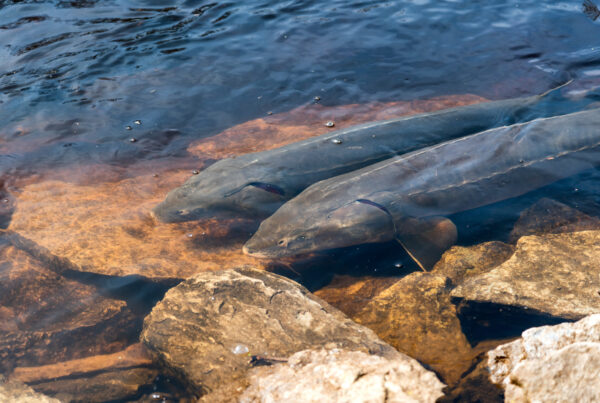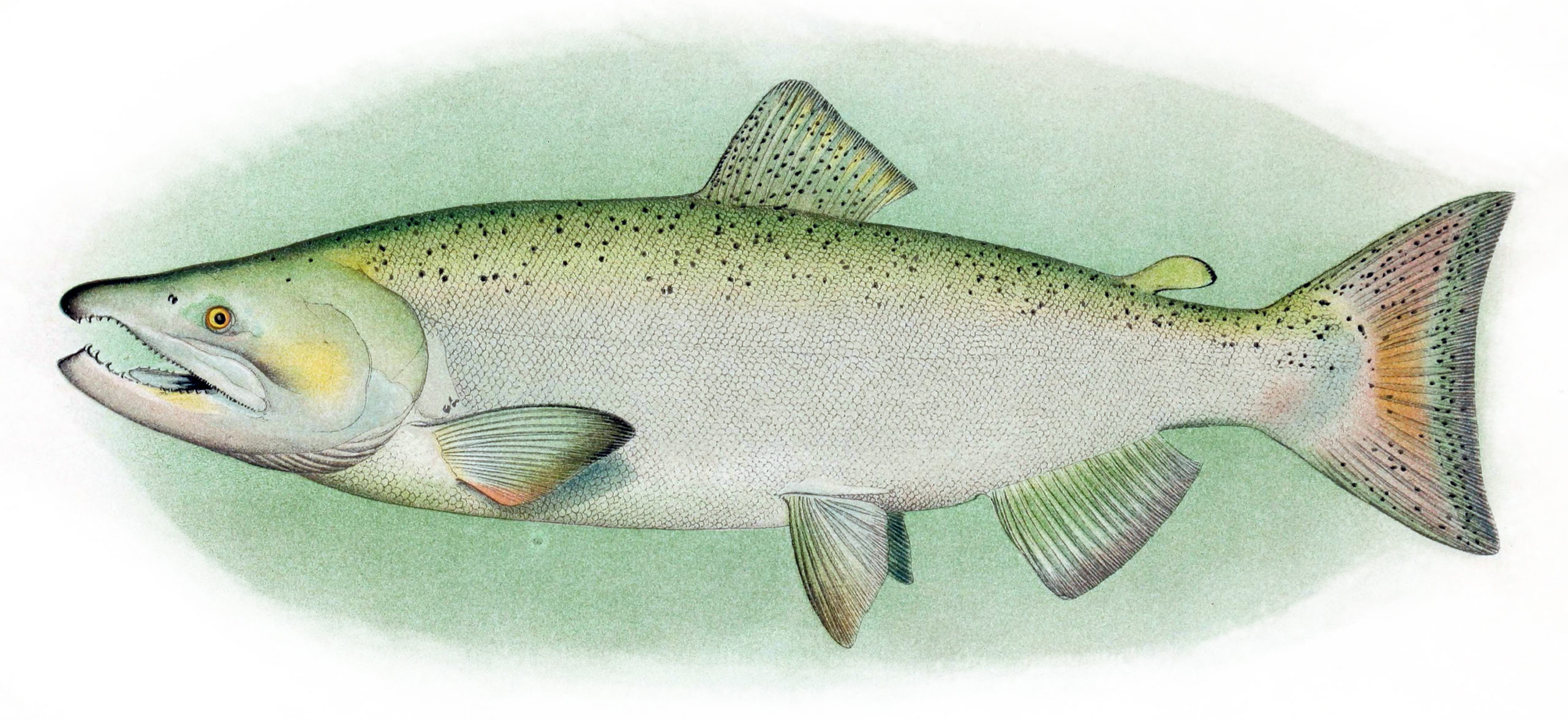
Since the 1960s, the state has been stocking Lake Michigan with Chinook salmon to help maintain the lake’s ecosystem and provide diverse fishing opportunities to anglers. As a result, more than half of the Chinook in Lake Michigan today are naturalized. But how has the salmon population changed over time? And are there significant differences between naturally produced and hatchery-stocked populations—differences that could upset the delicate balance of the state’s fisheries?
Since Michigan depends on the economic benefits of recreational fishing—and since the health of the lakes depends on making sound management decisions—the Great Lakes Fishery Trust (GLFT) funded a research project to (1) better understand the state’s more naturalized Chinook salmon population, (2) assess potential differences between naturalized and hatchery-stocked fish, and (3) use the results to inform decisions about cultivating self-sustaining stocks of desirable introduced species.
The Angle
To better understand how the Chinook salmon population has changed over time, a team of researchers from five organizations first looked at historical trend data. Then, the team conducted field studies to gather more information on the life-history characteristics of naturalized versus hatchery-stocked populations. Among other things, researchers hypothesized that age and size at maturity would diverge over time (because many life history traits are heritable), and naturalized fish would spawn at later ages and times of the year.
The Nitty-Gritty
Researchers began their work by examining 23 years of data. Then, they conducted field studies for two years to collect biological data on three different spawning populations in northwestern Lake Michigan: (1) a hatchery-stocked population, (2) a naturalized population, and (3) a mixed population whose origins could not be discerned. For each population, researchers evaluated age at maturity, weight and length at maturity, fecundity, egg size, and the months in which fish spawned. They also analyzed the total thiamine concentrations in Chinook egg subsamples to determine whether egg and larval survivability differed among the populations.
The Results Are In…
Much to their surprise, researchers found only minor differences in the life-history traits of the Chinook salmon population. Even as the population became more naturalized, data show that maturity at age did not change; length at maturity remained consistent; and the average weight at maturity declined, but only slightly. There also was a decrease over time in the ratio of males to females, but the decline was not as significant as expected.
When using more current field data to compare the three Chinook populations, researchers found no support for concerns about differing ages and sizes at maturity, fecundity, or the times at which the fish spawned. They did, however, find that mixed populations had the largest and heaviest eggs, whereas naturalized populations had the smallest.
One of the most interesting and unexpected findings was that egg thiamine concentrations, on average, were above the ED50 threshold (concentrations below the threshold are associated with 50 percent larval mortality). In fact, concentrations were higher than those previously reported, and there was no indication of high occurrences of thiamine deficiency. This finding is noteworthy because Chinook salmon now consume alewives, the primary driver of thiamine deficiency in Great Lakes salmonids.
What Does It all Mean?
While divergences between hatchery and naturalized Chinook salmon populations have become a serious concern in other areas of the country, this project data suggest there is no need to be overly worried about differences in the Great Lakes region, at least at this time. The life-history characteristics of the overall Chinook salmon population have remained fairly stable, and the characteristics of naturalized populations are similar to those of hatchery-produced populations. Therefore, the results suggest that an increasingly naturalized Chinook salmon population has neither adversely affected the salmon fishery nor will it do so in the future.
Further Reading
Research Shows Few Differences Between Naturalized and Stocked Salmon
Mark Rogers, a research fishery biologist with the U.S. Geological Survey and one of the primary investigators on a recent project funded by the Great Lakes Fishery Trust (GLFT), posed this fundamental question: As the population structure of Chinook salmon in Lake Michigan changes, should we expect the fishery to change, too? Project results suggest the answer might be no, or least not as much as we might expect. Given current concerns about the vulnerability and sustainability of the Chinook salmon population, this could be an important finding.
For their GLFT-funded project, Rogers and a team of researchers attempted to answer his question by looking at life-history characteristics in two ways. First, they examined 23 years of historical data to determine whether average life-history parameters changed as the Chinook salmon population became increasingly naturalized. (Naturalized fish now comprise more than 50 percent of the total Chinook salmon population in Lake Michigan.)
Second, the team conducted two years of field studies to gather data that might support or call into question what the trend data suggested. For the field study, researchers looked at spawning populations in northwestern Lake Michigan that were naturalized, hatchery-stocked, and mixed (e.g., their origins could not be discerned).
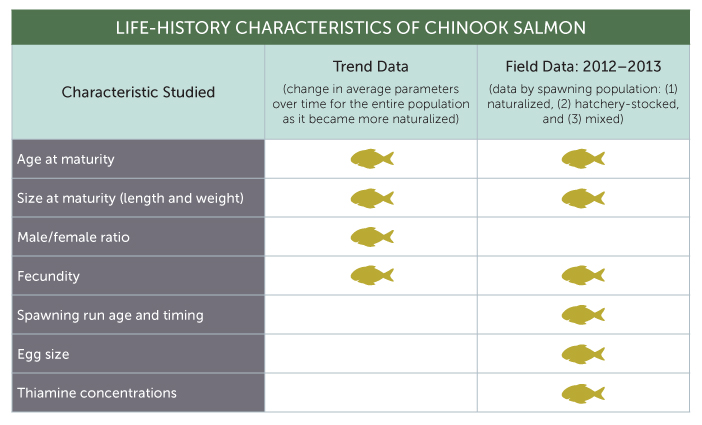 In a third part of the project, researchers analyzed the total concentrations of thiamine, a vitamin B structure, in Chinook eggs, which has implications for egg and larval survivability. Specifically, they wanted to understand whether naturalized salmon were less inclined toward thiamine deficiencies, which, at certain levels, can lead to early mortality syndrome.
In a third part of the project, researchers analyzed the total concentrations of thiamine, a vitamin B structure, in Chinook eggs, which has implications for egg and larval survivability. Specifically, they wanted to understand whether naturalized salmon were less inclined toward thiamine deficiencies, which, at certain levels, can lead to early mortality syndrome.
Many of the team’s findings were entirely unexpected, Rogers says. For example, researchers were fairly confident that naturalized fish would reach maturity later, which would cause them to spawn at later ages and at later times of the year (perhaps in October and November instead of August or September). Neither the trend data nor the field study data supported this hypothesis. Age at maturity did not change, length at maturity remained the same, and the time of year at which fish spawned showed no significant differences.
Randy Claramunt of the Charlevoix Fisheries Research Station, who served as a collaborator on the project, was surprised with this finding.
“Anglers often ask us if we have to manage wild salmon separately from stocked fish because wild fish are thought to spawn at older ages and later in the year,” he says. “The findings from this study show that wild and stocked salmon likely are not distinct subpopulations. Therefore, our current models on salmon abundance adequately reflect the mixed population.”
The only noticeable change in the salmon population over time was a slight decline in average weight. The decline, researchers learned, was not related to something inherent to the population, or even to stocking density (e.g., too many fish going after too few prey). Instead, they found that weight variations had a stronger relationship with prey fish abundance.
“In years where more prey was available, the fish were heavier,” Rogers says.
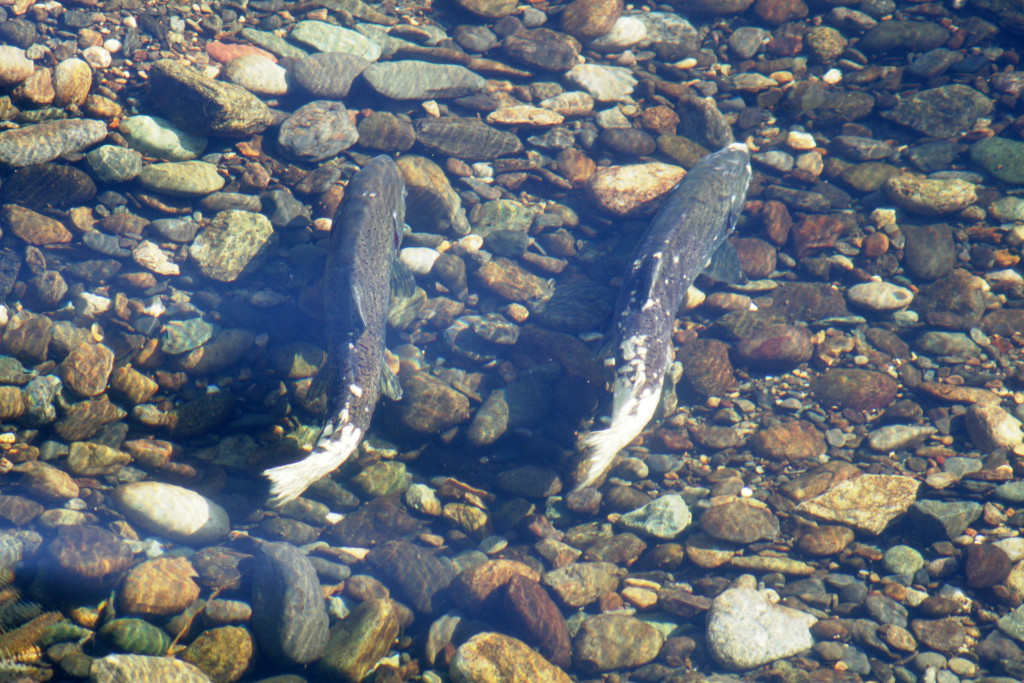
Chinook salmon (Oncorhynchus tshawytscha).
Another unexpected finding was that the ratio of males to females did not decline as precipitously as anticipated. The assumption that the population would reach a male/female balance over time is based on the fact that hatchery-stocked fish grow very fast during the first year of life. As a result, male fish reach maturity at age one or two instead of the expected age of three or four. These early maturing males are called “jacks.” Researchers surmised that as naturalized fish contributed more to the salmon population, there would be fewer jacks, thereby equalizing the number of males and females in the spawning population. The trend data from the GLFT project suggests that, while there has been some shift over 23 years, it is not as strong as expected. The Chinook salmon population in Lake Michigan is still male biased.
Yet another surprising finding relates to fecundity. As Rogers explains, “There is an evolutionary paradigm that the number and size of eggs a fish produces should be optimized for the habitat in which they are laid to maximize their survival. So, if you’re in a stable habitat—like a hatchery—the fish will invest its energy in making small eggs and a lot of them. But, if the fish is in a less stable habitat—maybe one with high and low water levels or other stressful conditions—it will invest its energy in laying fewer eggs that are larger.”
Ironically, researchers found that naturalized Chinook salmon, who live in less stable environments than hatchery-stocked fish, laid the smallest eggs. The mixed population had the largest, heaviest eggs, and the eggs of the hatchery-stocked population were in the middle. Among the three populations, however, there were no differences when comparing the total number of eggs laid to a female’s weight.
“If the naturalized fish had much larger eggs than the hatchery-stocked fish, that would imply the naturalized females were putting more energy into their eggs,” Rogers says. “If that energy comes from prey resources, the current prey biomass levels we’re experiencing in the lake, which are lower than in previous decades, could hurt the naturalized Chinook population. Since that’s not the case, we probably don’t have to worry.”
The final, and perhaps most unexpected, finding was that, on average, Chinook salmon egg thiamine concentrations were above the ED50 threshold (egg thiamine concentrations below ED50 are associated with 50 percent larval mortality).
“Thiamine is a vitamin B structure. Thiaminase is a vitamin B blocker that some prey fish have, like alewives. When the salmon consume the alewives with thiaminase, it inhibits thiamine production, which is important to egg and larval survival. So, having higher than expected levels of thiamine in salmon is good.”
While the findings of this study shed valuable light on the Chinook salmon population, Rogers cautions that they do not tell the whole story. The study only looked at fish in northwestern Lake Michigan; therefore, the results do not necessarily represent lakewide patterns. Furthermore, the study focused primarily on the increasing contribution of wild fish to the population. But as Rogers points out: “A lot has been going on in Lake Michigan since the conclusion of our study … that could affect the dynamic of the salmon fishery. So, while our results don’t suggest that the fishery is going to change, there are other things that could change it.”
Field Study Area and Survey Location Maps
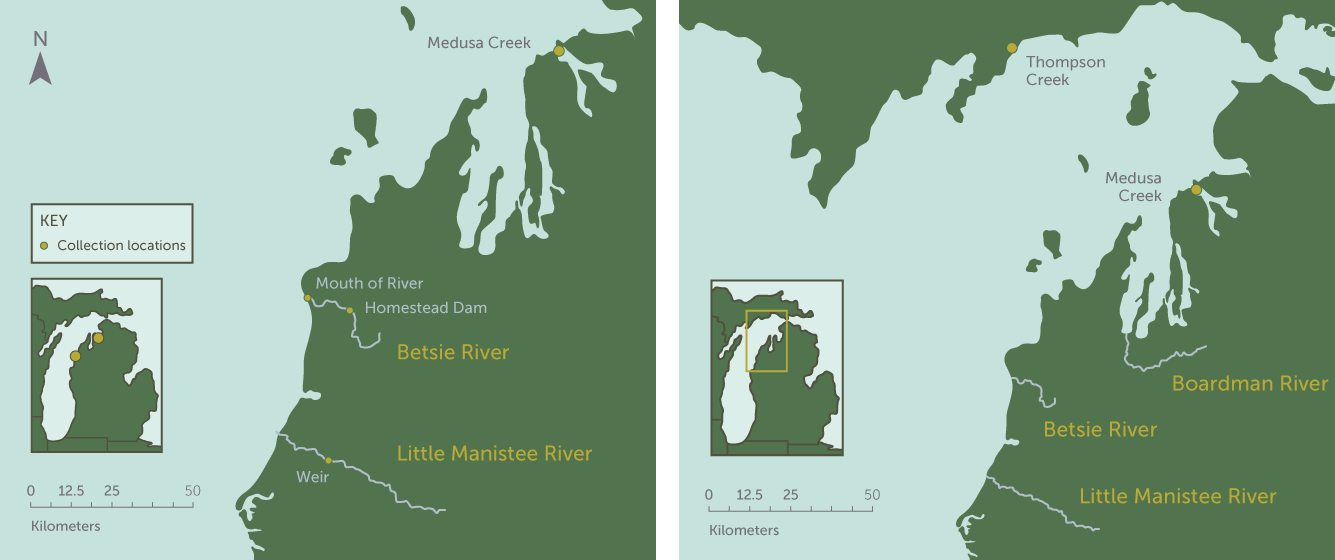
Map of field study areas and creel survey locations for Lake Michigan salmon life history conducted during the fall of 2012 and 2013 (left). Map of rivers and creeks where Chinook Salmon samples were collected for historical analyses (right).
Mark Coscarelli, trust manager for the GLFT, agrees with Rogers.
“While the data suggest that there are far fewer differences among naturalized and stocked fish than we imagined, the project underscores that life history characteristics are only one piece of a complex puzzle that drives salmon production in Lake Michigan,” he says. “As we witnessed with Lake Huron, the changing food web brought about by invasive species likely has far greater implications for the fishery.”
Full Article
Research Shows Few Differences Between Naturalized and Stocked Salmon
Mark Rogers, a research fishery biologist with the U.S. Geological Survey and one of the primary investigators on a recent project funded by the Great Lakes Fishery Trust (GLFT), posed this fundamental question: As the population structure of Chinook salmon in Lake Michigan changes, should we expect the fishery to change, too? Project results suggest the answer might be no, or least not as much as we might expect. Given current concerns about the vulnerability and sustainability of the Chinook salmon population, this could be an important finding.
For their GLFT-funded project, Rogers and a team of researchers attempted to answer his question by looking at life-history characteristics in two ways. First, they examined 23 years of historical data to determine whether average life-history parameters changed as the Chinook salmon population became increasingly naturalized. (Naturalized fish now comprise more than 50 percent of the total Chinook salmon population in Lake Michigan.)
Second, the team conducted two years of field studies to gather data that might support or call into question what the trend data suggested. For the field study, researchers looked at spawning populations in northwestern Lake Michigan that were naturalized, hatchery-stocked, and mixed (e.g., their origins could not be discerned).

In a third part of the project, researchers analyzed the total concentrations of thiamine, a vitamin B structure, in Chinook eggs, which has implications for egg and larval survivability. Specifically, they wanted to understand whether naturalized salmon were less inclined toward thiamine deficiencies, which, at certain levels, can lead to early mortality syndrome.
Many of the team’s findings were entirely unexpected, Rogers says. For example, researchers were fairly confident that naturalized fish would reach maturity later, which would cause them to spawn at later ages and at later times of the year (perhaps in October and November instead of August or September). Neither the trend data nor the field study data supported this hypothesis. Age at maturity did not change, length at maturity remained the same, and the time of year at which fish spawned showed no significant differences.
Randy Claramunt of the Charlevoix Fisheries Research Station, who served as a collaborator on the project, was surprised with this finding.
“Anglers often ask us if we have to manage wild salmon separately from stocked fish because wild fish are thought to spawn at older ages and later in the year,” he says. “The findings from this study show that wild and stocked salmon likely are not distinct subpopulations. Therefore, our current models on salmon abundance adequately reflect the mixed population.”
The only noticeable change in the salmon population over time was a slight decline in average weight. The decline, researchers learned, was not related to something inherent to the population, or even to stocking density (e.g., too many fish going after too few prey). Instead, they found that weight variations had a stronger relationship with prey fish abundance.
“In years where more prey was available, the fish were heavier,” Rogers says.

Chinook salmon (Oncorhynchus tshawytscha).
Another unexpected finding was that the ratio of males to females did not decline as precipitously as anticipated. The assumption that the population would reach a male/female balance over time is based on the fact that hatchery-stocked fish grow very fast during the first year of life. As a result, male fish reach maturity at age one or two instead of the expected age of three or four. These early maturing males are called “jacks.” Researchers surmised that as naturalized fish contributed more to the salmon population, there would be fewer jacks, thereby equalizing the number of males and females in the spawning population. The trend data from the GLFT project suggests that, while there has been some shift over 23 years, it is not as strong as expected. The Chinook salmon population in Lake Michigan is still male biased.
Yet another surprising finding relates to fecundity. As Rogers explains, “There is an evolutionary paradigm that the number and size of eggs a fish produces should be optimized for the habitat in which they are laid to maximize their survival. So, if you’re in a stable habitat—like a hatchery—the fish will invest its energy in making small eggs and a lot of them. But, if the fish is in a less stable habitat—maybe one with high and low water levels or other stressful conditions—it will invest its energy in laying fewer eggs that are larger.”
Ironically, researchers found that naturalized Chinook salmon, who live in less stable environments than hatchery-stocked fish, laid the smallest eggs. The mixed population had the largest, heaviest eggs, and the eggs of the hatchery-stocked population were in the middle. Among the three populations, however, there were no differences when comparing the total number of eggs laid to a female’s weight.
“If the naturalized fish had much larger eggs than the hatchery-stocked fish, that would imply the naturalized females were putting more energy into their eggs,” Rogers says. “If that energy comes from prey resources, the current prey biomass levels we’re experiencing in the lake, which are lower than in previous decades, could hurt the naturalized Chinook population. Since that’s not the case, we probably don’t have to worry.”
The final, and perhaps most unexpected, finding was that, on average, Chinook salmon egg thiamine concentrations were above the ED50 threshold (egg thiamine concentrations below ED50 are associated with 50 percent larval mortality).
“Thiamine is a vitamin B structure. Thiaminase is a vitamin B blocker that some prey fish have, like alewives. When the salmon consume the alewives with thiaminase, it inhibits thiamine production, which is important to egg and larval survival. So, having higher than expected levels of thiamine in salmon is good.”
While the findings of this study shed valuable light on the Chinook salmon population, Rogers cautions that they do not tell the whole story. The study only looked at fish in northwestern Lake Michigan; therefore, the results do not necessarily represent lakewide patterns. Furthermore, the study focused primarily on the increasing contribution of wild fish to the population. But as Rogers points out: “A lot has been going on in Lake Michigan since the conclusion of our study … that could affect the dynamic of the salmon fishery. So, while our results don’t suggest that the fishery is going to change, there are other things that could change it.”
Field Study Area and Survey Location Maps

Map of field study areas and creel survey locations for Lake Michigan salmon life history conducted during the fall of 2012 and 2013 (left). Map of rivers and creeks where Chinook Salmon samples were collected for historical analyses (right).
Mark Coscarelli, trust manager for the GLFT, agrees with Rogers.
“While the data suggest that there are far fewer differences among naturalized and stocked fish than we imagined, the project underscores that life history characteristics are only one piece of a complex puzzle that drives salmon production in Lake Michigan,” he says. “As we witnessed with Lake Huron, the changing food web brought about by invasive species likely has far greater implications for the fishery.”
